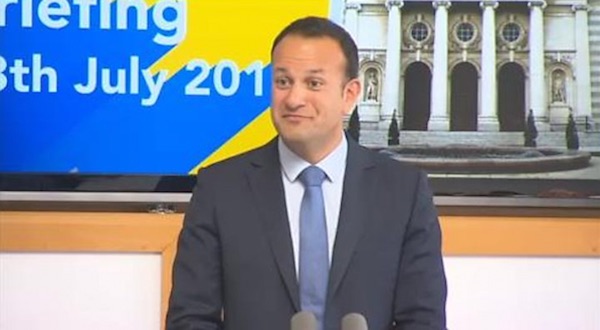
There are indications that the Dublin government may be waking up to the risks involved in reinforcing the partition of Ireland after it rejected the prospect of a new economic border to impose Brexit.
The 26 County Taoiseach Leo Varadkar said if Britain wants to propose technological solutions for a ‘frictionless’ border between the two jurisdictions on the island, that is “up to them”.
“What we’re not going to do is to design a border for the Brexiteers because they’re the ones who want a border,” he said.
“It’s up to them to say what it is, say how it would work and first of all convince their own people, their own voters that this is actually a good idea.
“So let them forward their proposals as to how they think a border should operate and we’ll ask them if they really think this is such a good idea.”
The media described the response as a “hard-hitting” following criticism of his recent meeting with British Prime Minister Theresa May at Downing Street in which he appeared overawed and, revealed he was put in mind of the romantic comedy, ‘Love Actually’.
Mr Varadkar dismissed suggestions by reporters there would be “an angry response” by unionists and Tories to his government’s “defiance”.
“It is the British and the Brexiteers who are leaving, so if anyone should be angry it’s us quite frankly,” he said.
“But we are not going to get angry. We are going to try and find solutions or at least minimise the damage to relations between Britain and Ireland, to the peace process and to trading links,” he said.
He said both he and Minister for Foreign Affairs Simon Coveney are in agreement on the issue.
Earlier, Mr Coveney said Ireland cannot support proposals resulting in border checkpoints across the island, and that Brexit will require “flexible and imaginative solutions”. Last week he also dismissed British suggestions that the use of scanning and camera equipment would allow the border to be “invisible”.
However, he backed away from a report in the Times newspaper that the Dublin government believes the Irish Sea is the most natural post-Brexit border.
Speaking on Irish state TV, Minister Coveney said Britain has chosen to leave the EU and there is an onus on it to make sure the consequences of that decision do not harm Ireland.
He said: “We have a border that is 500km long. There are 400 road crossings along that border.
“Anybody who suggests to me that we can solve this problem by putting cameras on this border ... I don’t think that is the approach we can take.”
The DUP, needed by British Prime Minister Theresa May to prop up her minority administration in the House of Commons, said the suggestion of customs and immigrations checks at ports after Brexit as “absurd and unconstitutional”.
DUP MP Ian Paisley said his party would use its influence over the Tory government to spike the idea. He said the position of the Dublin government appeared to leave two alternatives - a “very hard border” or that “Ireland will wise up and leave the EU” as well.
Ulster Unionist Party leader Robin Swann claimed the Taoiseach was going to “use the border to make a name for himself”. Although a majority of voters in the Six Counties voted to remain in the EU, Swann claimed Mr Varadkar is “showing total disrespect to the people of Northern Ireland and their right to self determination”.
‘SHAMBLES’
Sinn Fein MEP Martina Anderson meanwhile branded the Conservative government’s Brexit process as “clueless and a shambles”.
She was speaking after London announced that free movement of people between the EU and its jurisdiction would end in March 2019.
“They have provided no detail about how they propose to tackle the disastrous impact of Brexit on our economy, on agriculture, on human rights, on the issue of the border, on the Good Friday Agreement or on the future of EU citizens who have made Ireland their home,” she said.
![[Irish Republican News]](https://republican-news.org/graphics/title_gifs/rn.gif)
![[Irish Republican News]](https://republican-news.org/graphics/title_gifs/harp.gif)

